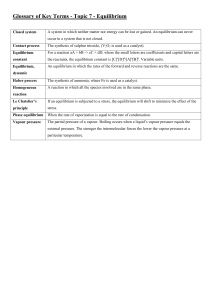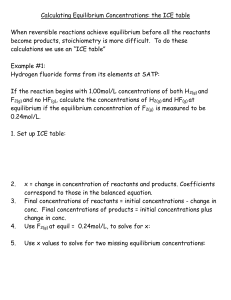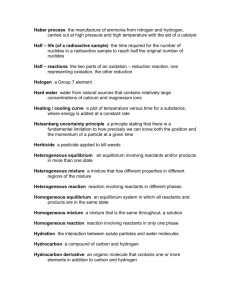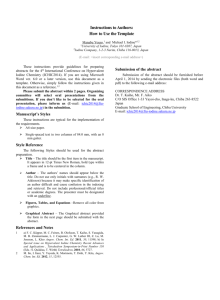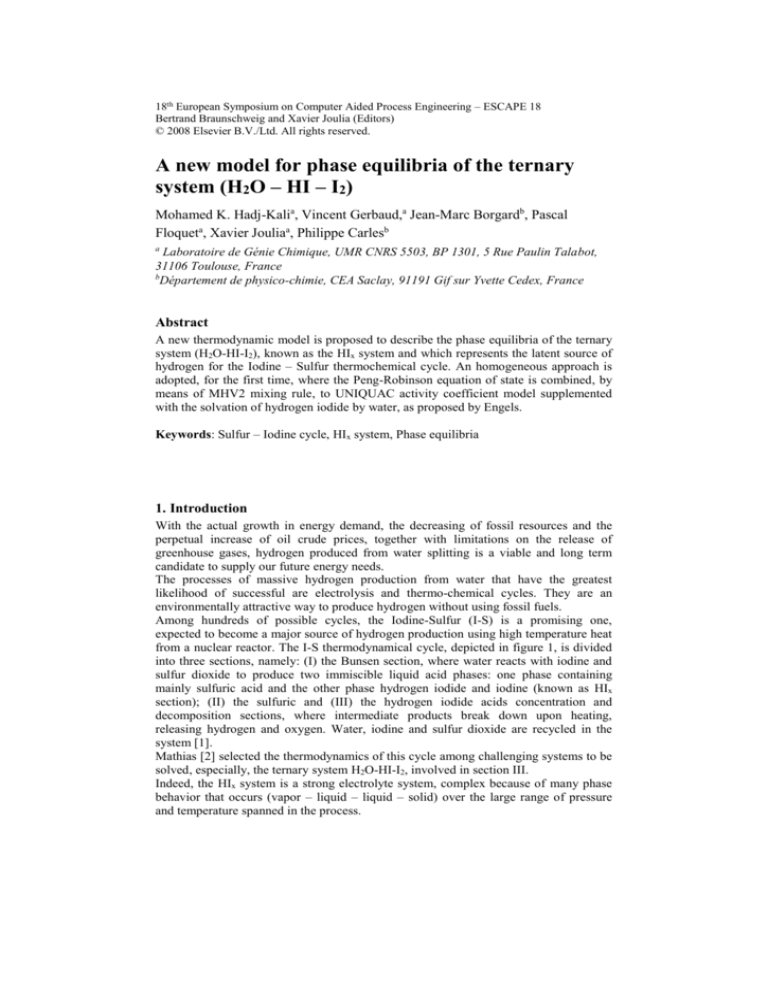
18th European Symposium on Computer Aided Process Engineering – ESCAPE 18
Bertrand Braunschweig and Xavier Joulia (Editors)
© 2008 Elsevier B.V./Ltd. All rights reserved.
A new model for phase equilibria of the ternary
system (H2O – HI – I2)
Mohamed K. Hadj-Kalia, Vincent Gerbaud,a Jean-Marc Borgardb, Pascal
Floqueta, Xavier Jouliaa, Philippe Carlesb
a
Laboratoire de Génie Chimique, UMR CNRS 5503, BP 1301, 5 Rue Paulin Talabot,
31106 Toulouse, France
b
Département de physico-chimie, CEA Saclay, 91191 Gif sur Yvette Cedex, France
Abstract
A new thermodynamic model is proposed to describe the phase equilibria of the ternary
system (H2O-HI-I2), known as the HIx system and which represents the latent source of
hydrogen for the Iodine – Sulfur thermochemical cycle. An homogeneous approach is
adopted, for the first time, where the Peng-Robinson equation of state is combined, by
means of MHV2 mixing rule, to UNIQUAC activity coefficient model supplemented
with the solvation of hydrogen iodide by water, as proposed by Engels.
Keywords: Sulfur – Iodine cycle, HIx system, Phase equilibria
1. Introduction
With the actual growth in energy demand, the decreasing of fossil resources and the
perpetual increase of oil crude prices, together with limitations on the release of
greenhouse gases, hydrogen produced from water splitting is a viable and long term
candidate to supply our future energy needs.
The processes of massive hydrogen production from water that have the greatest
likelihood of successful are electrolysis and thermo-chemical cycles. They are an
environmentally attractive way to produce hydrogen without using fossil fuels.
Among hundreds of possible cycles, the Iodine-Sulfur (I-S) is a promising one,
expected to become a major source of hydrogen production using high temperature heat
from a nuclear reactor. The I-S thermodynamical cycle, depicted in figure 1, is divided
into three sections, namely: (I) the Bunsen section, where water reacts with iodine and
sulfur dioxide to produce two immiscible liquid acid phases: one phase containing
mainly sulfuric acid and the other phase hydrogen iodide and iodine (known as HIx
section); (II) the sulfuric and (III) the hydrogen iodide acids concentration and
decomposition sections, where intermediate products break down upon heating,
releasing hydrogen and oxygen. Water, iodine and sulfur dioxide are recycled in the
system [1].
Mathias [2] selected the thermodynamics of this cycle among challenging systems to be
solved, especially, the ternary system H2O-HI-I2, involved in section III.
Indeed, the HIx system is a strong electrolyte system, complex because of many phase
behavior that occurs (vapor – liquid – liquid – solid) over the large range of pressure
and temperature spanned in the process.
2
M. K. Hadj-Kali et al.
The present work focuses on the thermodynamic modelling of the HIx system using
experimental data available in literature with the aim of validating it, thereafter, on new
experimental data of CEA (French Nuclear Energy Agency) under acquirement.
TEMPERATURE (°C)
O2
1000
II
800
H2SO4 DECOMPOSITION
H2SO4 SO2 + H2O + ½ O2
600
H2O
H2
H2SO4
400
SO2
HI DECOMPOSITION
III
2HI H2 + I2
HIx
200
I2
I
0
BUNSEN REACTION
H2O
xI2 + SO2 + 2H2O H2SO4 + 2HIx
H2O
Figure1. Iodine - Sulfur thermochemical cycle scheme [1].
This paper is organized as follows. First, available literature experimental data are
presented in detail. Then, a new model is presented and compared to former models and
validated vs selected experimental data. Finally, conclusion and future works under
investigation are mentioned.
2. Available experimental data
Before developing the model and parameters estimation procedure, it is necessary to
collect and analyse available experimental data for the ternary system (HI-I2-H2O) and
each binary subsystem (H2O-HI), (H2O-I2) and (HI-I2) (see table 1).
2.1. H2O-HI binary
Total pressures of HI-H2O binary mixtures have been measured by Wüster [3] and the
mixing enthalpies by Vanderzee [4]. H2O-HI mixture exhibits an azeotrope (xHI = 0.156
at 126.50°C). For HI concentrations higher than the azeotrope the vapour phase is very
rich in HI. Furthermore, for high temperatures (>200°C) HI dissociation in the vapour
phase into H2 and I2 becomes significant. These experimental results have been used by
Engels [5] to estimate the binary interaction parameters of the so called Engels solvation
model using the Wilson activity coefficient model.
Atmospheric vapour liquid equilibrium curve of this system has been measured by Sako
in 1985 [6] and earlier by Ducasse in 1926 [7]. These two authors measured both vapour
and liquid equilibrium compositions at different temperatures. In 1963, Haase [8] gave
at 25°C the isothermal vapour liquid equilibrium curve and showed that this system
demixes into a liquid-liquid equilibrium above xHI=0.346. Unpublished experimental
data of Norman and O’Keefe found in the work of Neumann [9], confirm this fact and
indicate the composition of the aqueous phase at five higher temperatures.
A new model for phase equilibria of the ternary system (H2O – HI – I2)
3
Table 1. Experimental available data in literature for HIx system and its binary sub-systems.
H2O-HI
H2O-I2
HI-I2
H2O-HI-I2
Used
Data
type
Data
number
Data source
V-L
80
V-L
regression
validation
Wüster [3]
-
38
Pascal [7]
-
V-L
30
Sako [6]
-
V-L
21
Haase [8]
-
L-L
5
Neumann [9]
-
L-L
1
Haase [8]
-
HE
13
Vanderzee [4]
no
no
L-L
10
Kracek [10]
-
S-L
10
Kracek [10]
-
S-L
5
O’Keefe [11]
-
V-L
280
Neumann [9]
-
L-L
12
Norman [13]
no
no
2.2. H2O-I2 binary
H2O-I2 has been studied by Kracek [10] in 1931, who measured the solubility of iodine
in water and put in evidence a miscibility gap lying between the solid-liquid equilibrium
point at 112.3°C (close to the melting point of iodine) and an upper temperature of
approximately 210°C. At 112.3°C, the light aqueous liquid phase contains 0.05 mole %
of iodine and the heavy iodine liquid phase 98 mole % of iodine.
2.3. HI-I2 binary
The only available data for HI-I2 concerns the solubility of iodine in HI measured by
O’Keefe and Norman [11] at five different temperatures. This work highlights that HI-I2
solutions follow quite closely an ideal behavior.
2.4. H2O-HI-I2 ternary
Total pressure measurements for a [HI]/[H20] ratio up to 19% and various iodine
concentrations are found in Neumann [9]. A synthesis of these results has been
published by Engels et al. [12]. The liquid phase exhibits two miscibility gaps: one for
low HI contents, due to the very low miscibility of I 2 in H2O, and the second, found by
Norman [13], for high HI contents and about 30% water/iodine concentration. The first
one tends to disappear with increasing HI concentration, probably because of the
formation of polyiodides ions like I3- [14].
All these data are reported in table 1. As highlited, some are used for model
identification and others for validation.
3. Thermodynamic model
For modelling fluid-phase equilibria, a common practice is to use either a heterogeneous
(γ-φ) or a homogenous (φ-φ) approach [15].
4
M. K. Hadj-Kali et al.
In the heterogeneous approach, vapour and liquid phases are handled differently.
Reference state is perfect gas for the vapour phase and the fugacity coefficients φ
(obtained from an equation of state (EOS)) are used to model real gas behavior. For
the liquid phase, the reference state is ideal liquid and activity coefficients γ (derived
from a model of molar excess Gibbs energy) are calculated to account for the nonideality of the liquid phase.
In homogeneous approach, the reference state, perfect gas, is the same for both
vapour and liquid phases and fugacity coefficients φ are calculated from a unique
EOS for all components in all fluid phases.
Until this work, all published models for the (H2O-HI-I2) are derived from a
heterogeneous approach:
The Neumann model inspired by Engels’s solvation model combines a modified
NRTL model with the solvation of HI by H2O (mH20 + HI [(H30+, (m-1)H20), I-])
put together to describe the non-ideality of the liquid phase. This model was used
earlier by several authors [16, 17], to describe a reactive distillation column.
Mathias and co-workers proposed to use an electrolyte model of Chen et al. [18]
combining an asymmetric NRTL model with a Pitzer term.
Whereas the vapour is assumed to behave like a perfect gas for these two models,
Annesini et al. [19] use the RK EOS to calculate the gas phase fugacity and the
electrolyte-NRTL activity coefficient model of Chen for the liquid phase.
We propose for the first time a HIx system model following a homogeneous approach.
Both phases are described by the same EOS: Peng Robinson with Boston Mathias alpha
function (PRBM). The MHV2 complex mixing rule is then used to better handle the non
ideality of the liquid phase. This mixing rule includes an excess Gibbs energy model
and we choose a combination of the UNIQUAC activity coefficient model with the
solvation of HI by H2O that we call UQSolv.
Compared to the heterogeneous approach, a homogeneous one with a complex mixing
rule adds EOS accurate prediction of VLE at high pressure and temperature, esp. above
Tcrit,HI=150,7°C; a reference state valid for all compositions, unlike the asymmetric
electrolyte convention for HI; handling of liquid non ideal behavior via the excess
Gibbs energy model.
Model development is achieved within Simulis Thermodynamics, a ProSim™ thermophysical properties calculation server available as a MS-Excel add-in and CAPE-OPEN
compliant component [20].
4. Model Identification and results
The methodology adopted to estimate model parameters consists in dealing separately
with each binary subsystem before refining the parameters of the ternary system.
For the first step, only UNIQUAC binary interaction parameters were regressed for both
H2O-I2 and HI-I2. Then, for the H2O-HI binary, hydrogen iodide solvation by water is
considered and the solvation parameters are simultaneously regressed with the
UNIQUAC binary interaction parameters between H2O, HI and the solvation complex.
As it can be seen in figure 2, the H2O-I2 mixture is highly non ideal with L-L
equilibrium exhibited above the eutectic temperature (112,3 °C). Both Neumann’s and
UQSolv (UNIQUAC + solvation) match correctly the experimental equilibrium curve in
the iodine phase. But our model remains better for the aqueous phase. In addition, our
prediction of solid iodine solubility in water at low temperatures is very good.
A new model for phase equilibria of the ternary system (H2O – HI – I2)
5
Temperature (°C)
Heavy iodine
liquid phase
(L’’)
(L’ + L’’)
Eutectic 112.3°C
Light aqueous
liquid phase
(L’)
Light aqueous liquid phase
+ Solid iodine
(L’ + S)
0,85
Tmelting I2
113.6°C
0,90
0,95
1,00
Iodine molar fraction
Figure 2. Experimental and calculated H2O – I2 liquid-liquid and solid-liquid equilibrium curves
At low pressure, heterogeneous and homogeneous approaches together join. It is why,
concerning H2O-HI binary, interaction parameters are fitted at low pressures using the
heterogeneous approach (UQSol + PRBM) on the basis of the experimental vapor –
liquid equilibrium data of Wüster [3] and liquid – liquid equilibrium data of Haase [8]
and Neumann [19]. At high pressure, those parameters are used within the MHV2
mixing rule for the PRBM EOS.
Identification is performed on all experimental data, except those on the right side of
azeotrope where experimental uncertainty is high because of difficulties to assess the
experimental liquid composition and because of HI vapor decomposition observed.
Figure 3 shows the model prediction versus experimental liquid – vapor equilibrium
data for the binary system H2O-HI at atmospheric pressure. Obviously, our model
accurately represents experimental results in the domain of database used for
identification (xHI<17%) but with a noteworthy discrepancy on the right of the
azeotrope where the experimental data are still uncertain.
exp bubble points (Ducasse 1926 in Pascal, 1960)
exp dew points (Ducasse 1926 in Pascal, 1960)
PRBM+UQSolv
ELL P=1atm PRBM+UQsolv
V
140
413,15
120
393,15
L1 + V
100
373,15
Température °C°C
353,15
80
333,15
60
L1 + V
313,15
40
L1
293,15
20
273,15
0
253,15
-20
233,15
-40
213,15
-60
0
0,1
0,2
0,3
0,4
0,5
0,6
0,7
0,8
0,9
1
L1 + L2
PRBM + UQsolv
HI molar
fraction
HI Molar
fraction
Figure 3: Water – Hydrogen iodide isobaric liquid – vapor equilibrium curve at P=1atm.
6
M. K. Hadj-Kali et al.
Another significant achievement of the proposed model is the quantitative prediction of
the liquid – liquid equilibrium above xHI=0.36 as expected by experiment [8, 9].
For the ternary system, keeping constant both the binary interaction parameters
regressed for each binary system and the solvation parameters of hydrogen iodide by
water, the ternary L-V equilibrium data are fitted by estimating the interaction between
iodine and the solvation complex. The resulting model provides a fair description of the
V-L equilibrium behaviour with an absolute average error lower than 9% and a
maximum error less than 45% (resp. 9.6% and 64% for Neuman’s model). However, LL equilibrium remains to be validated, especially in the region of the ternary diagram
between water and hydrogen iodide.
5. Conclusion
The highly non ideal HIx system has been modeled by an homogeneous approach based
on the Peng-Robinson equation of state with MHV2 complex mixing rule including
UNIQUAC activity coefficient model and a solvation equilibrium of HI by H2O. This
approach is well suited for expected process temperature and pressure conditions that
may be high and probably higher than the HI critical temperature (150,7°C). The
resulting model (PRBM + MHV2 + UQsolv) successfully represents most of the liquidvapor, liquid-liquid, liquid-solid, liquid-liquid-vapor experimental data available from
the literature. The largest discrepancy is found for high HI concentration mixtures
where experimental data are sparse and uncertain.
Improvements are under investigation including polyiodide ions formation and HI
decomposition in iodine and hydrogen for the vapor phase rich in HI.
At the same time, an experimental campaign for acquiring vapor – liquid – equilibrium
data for the ternary system has been launched by CEA, with the aim of enhancing the
thermodynamic knowledge of the phase equilibrium.
References
[1] D. O’keefe, C. Allen, G. Besenbruch, L. Brown, J. Norman, R. Sharp and K. McCorkle,
1982, Int. J. Hydrogen Energy, 7(5), 381-392.
[2] P. M. Mathias, 2005, Fluid Phase Equilibria, 228-229, 49-57.
[3] G. Wüster, 1979, Thesis, RWTH Aachen. (in German)
[4] C. E. Vanderzee and L. J. Gier, 1974, J. Chem. Thermodynamics, 6, 441-452.
[5] H. Engels, 1990, Chemistry data Series, Volume XI, Part I. Published by DECHEMA.
[6] T. Sako, T. Hakuta, H. Yoshitome, 1985, Kagaku Gijutsu Kenkyusho Hokoku, 199, 80.
[7] P. Pascal, 1960, Nouveau traité de chimie minérale, Edition Masson.
[8] R. Haase, H. Naas and H. Thumm, 1963, Z. Phys. Chem. NF, 37, 210.
[9] D. Neumann, 1987, Diplomaufgabe, RWTH Aachen. (in German)
[10] F. C. Kracek, 1931, J. Phys. Chem., 35, 417.
[11] D. R. O’Keefe and J. H. Norman, 1982, J. Chem. Eng. Data, 27, 77-80.
[12] H. Engels and K. Knoche, 1986, Int. J. Hydrogen Energy, 11(11), 703-707.
[13] J. H. Norman, 1985 (unpublished data).
[14] A. D. Palmer and M. H. Lietzke, 1982, Radiochimica Acta, 31, 37-44.
[15] S. I. Sandler, 1994, Models for thermodynamics and phase equilibria calculations, Marcel
Dekker, Inc. ISBN : 0-8247-9130-4.
[16] S. Goldstein, J-M Borgard and X Vitart, 2005, Int. J. Hydrogen Energy, 30, 619.
[17] S. Goldstein, J-M. Borgard, X. Joulia, P. Floquet, P. Guittard, 2003, AIChE Spring Meeting.
[18] C. Chen, H. I. Britt, J. F. Boston and L. B. Evans, 1982, AIChE Journal, 28(4), 588-596.
[19] M. C. Annesini, F. Gironi, M. Lanchi, L. Marrelli and M. Maschietti, June 2007,
Proceedings of ICheaP-8, The eigth Italian Conference on Chemical and Process Engineering.
[20] http://www.prosim.net/




